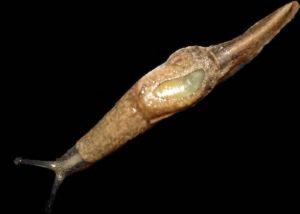Task Force on Rat Lungworm Developed

The semi-slug that has been heavily implicated in transmission of rat lung worm disease. University of Hawai’i photo.
A joint task force to assess the threat of rat lungworm disease in Hawai’i has been developed.
The task force was established by the Hawai’i State Department of Health and the East Hawai’i Liaison to the Office of the Governor.
Together, the task force will share scientific knowledge in the application of diagnostics, treatment, mitigation, and public education activities.
A nematode causes the disease. The nematode is a roundworm parasite called Angiostrongylus cantonensis. It can be passed from the feces of infected rodents to snails, slugs and certain other animals, which becomes intermediate hosts for the parasite.
Humans can become infected when they consume infected raw or undercooked intermediate hosts.
Rat lungworm has been found throughout the state, with the Big Island having the majority of the cases.
Some infections do not show any symptoms in humans, or surface only as mild symptoms. Others experience severe symptoms like headaches, stiffness of the neck, tingling or painful feelings in the skin or extremities, low-grade fever, nausea, and vomiting.
Sometimes, a temporary paralysis of the face may also be present, as well as light sensitivity. This infection can also cause a rare type of meningitis known as eosinophilic meningitis.
“Establishing a joint task force with local experts in the medical field and leaders in government will produce a set of best practices that be used to target rat lungworm disease not only on Hawai’i Island, but on a statewide scale as well,” said Wil Okabe, East Hawai’i Liaison to the Office of the Governor. “There is no specific treatment yet identified for this disease, so finding the best ways to prevent its spread and educate the public is crucial.”
The members of the task force include:
Wil Okabe (Facilitator), East Hawai’i Governor’s Liaison Office
Robert Cowie, Ph.D., Pacific Biosciences Research Center, University of Hawai’i at Manoa
Robert Hollingsworth, Ph.D., U.S. Department of Agriculture (USDA)
Sue Jarvi, Ph.D., School of Pharmacy, University of Hawai’i at Hilo
Jerry Kahana, Hawaii State Department of Agriculture
Kenton Kramer, Ph.D., Department of Tropical Medicine, John A. Burns School of Medicine (JABSOM)
John Martell, M.D., Hilo Medical Center
Marian Melish, M.D., Pediatric Infectious Disease, Kapiolani Medical Center
Donn Mende, Research and Development, County of Hawai’i
DeWolfe Miller, Ph.D., Tropical Medicine Microbiology and Pharmacology, JABSOM
Peter Oshiro, Sanitation Branch, DOH
Sarah Park, M.D., F.A.A.P., State Epidemiologist, DOH
Joanna Seto, Save Drinking Water Branch, DOH
Aaron Ueno, Hawai’i District Health Office, DOH
Chris Whelen, Ph.D., State Laboratories Division, DOH
Jonnie Yates, M.D., Kaiser Permanente











